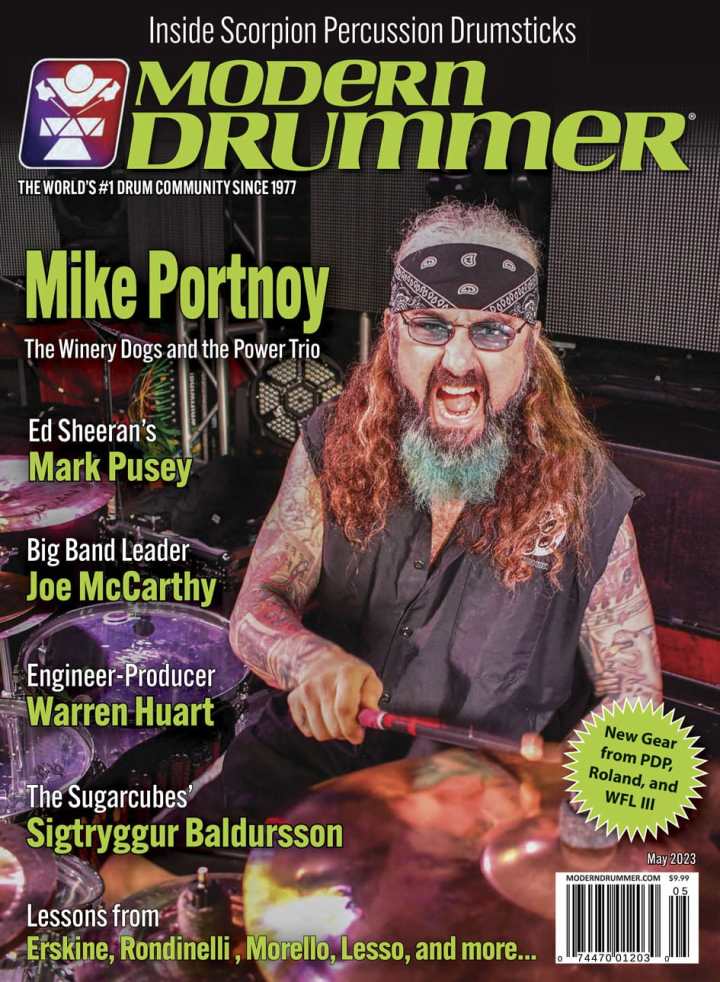Mike Portnoy The Winery Dogs and the Power of III
Mike Portnoy must be the busiest drummer in the business. He is an active touring and recording member of no less than ten different bands, and he does some sideman work. In the 12 years since he left Dream Theater his playing, has matured and developed, and his career has exploded. Musicians and careers evolve, and nowhere is this evolution on better display than with Portnoy’s drumming in The Winery Dogs. The Winery Dogs are a power trio based in hooky and catchy songs, three-part harmonies, and deep grooves. Billy Sheehan and Mike Portnoy are developing into quite a team, and Richie Kotzen is singing his butt off and giving Sheehan and Portnoy strong tunes on which to leave their thumbprints. The Winery Dogs are a band that can do it all! Get ready as Mike opens up to Modern Drummer up about his drumming, his bands, his career, his influences, and The Winery Dogs.
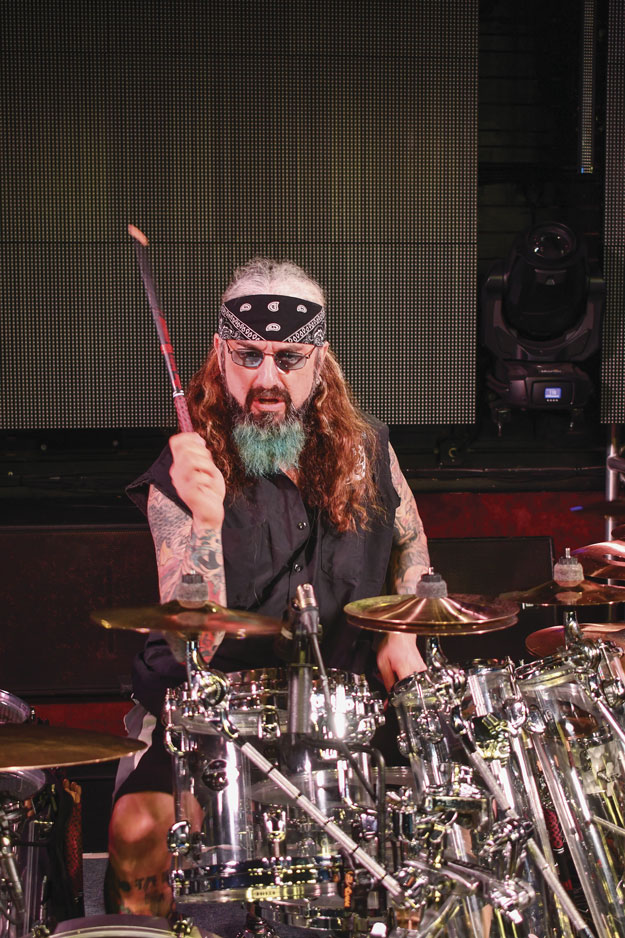
MD: The last tours you did with John Petrucci and The Winery Dogs were both with power trios. That’s a fun musical environment. How are you approaching the power trio differently from the slightly larger bands that you are in like The Neal Morse Band and Flying Colors?
MP: I love the whole vibe, the power trio gives you so much space to play. One of my biggest musical influences is Rush, obviously they are more of a prog power trio, but when you break it down it’s just the three of them. But my love for power trios started before that with Cream and the Jimi Hendrix Experience. Even if you look at The Who and Zeppelin; essentially those were power trios, they just happen to have a fourth person that sang, but the instrumentation was that power trio sound. I just love it because it gives you so much room to stretch.
With The Winery Dogs you have Richie Kotzen on guitar, Billy Sheehan on bass, and me on drums, and all three of us are singing as well. I love the three-part harmony aspect. All three of us are very predominant musical personalities. John Petrucci’s solo tour was a trio too, but that was a very different kind of trio than The Winery Dogs. Winery Dogs is more old school, three-part vocal, classic rock trio, that is very song driven. John Petrucci, Dave LaRue, and myself are the other side of the power trio which is all instrumental, very progressive, with (almost) jazz fusion aspects and elements to it as well.
Advertisement
MD: How does the additional space that a trio provides influence how and what you play? Do you approach trios differently?
MP: In a trio you have a lot more responsibility because you don’t have two guitar players or keyboards, so the drums must cover a lot of ground. However, I think the bass player in the trio really has to cover a lot more space, and obviously with Billy Sheehan is the right guy to fill up space and groove. In The Winery Dogs, Billy and I have a Keith Moon and John Entwistle type of musical relationship from The Who. In The Who, Keith and John were the acrobats, they were the ones going nuts and filling up the space, while Roger and Pete were the anchors and the foundation of the songs, that’s similar to The Winery Dogs where Billy and I are just running circles around Richie who’s kind of the anchor of the song.
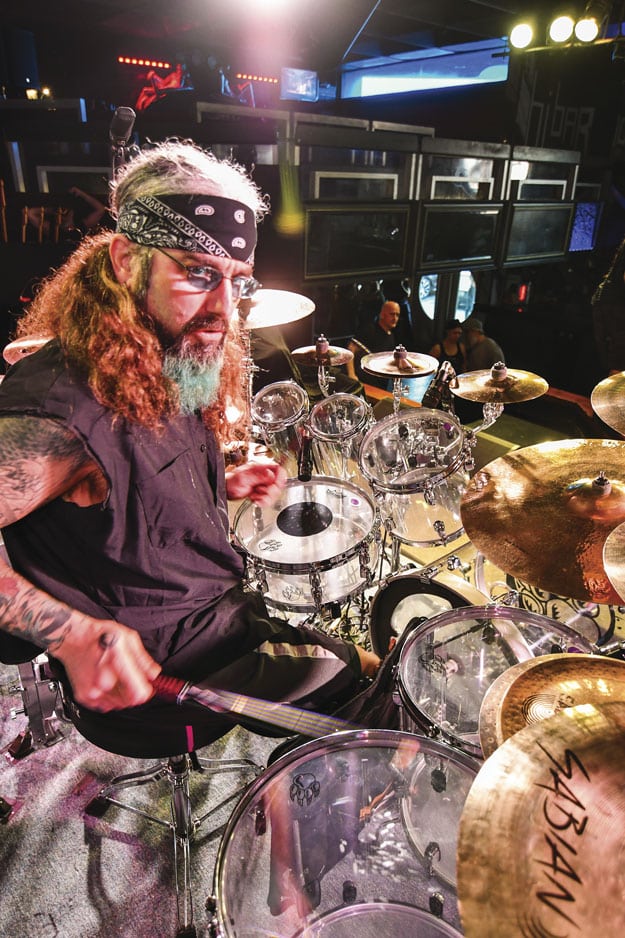
MD: I’m glad you brought up The Who. I know you’re a Who and Moon fan, why do you think that always worked? I’m constantly amazed by Keith and John because they each played a lot, but they never stepped on others on each other’s feet. That’s just unbelievable to me.
MP: That’s what made them so great. Obviously, Keith had a reputation for being a little “over the top,” and a little “sloppy.” To me, that’s the charm. That’s why I loved him so much. His reckless abandon is what made him so great. He played with so much personality, it just puts a smile on my face. Like you said, it’s always teetering on the edge of a train wreck, but the train never really crashes. Because Pete and Roger were the anchors, John and Keith were able to patrol the outer periphery and play like lead instruments. Advertisement
MD: It always seemed like Pete was the “drummer” and Moon was the “lead guitarist” in The Who.
MP: One of the very first things Billy and I did back in 2006 was a Who tribute band that I put together. I never even considered another bass player for that band. It had to be Billy. He and I were just so tapped into John and Keith’s frame of mind, it was so much fun to do that. It’s actually very similar to what we are doing now with The Winery Dogs.
Tommy was my initiation into The Who, believe it or not I was listening to Tommy when it came out and I was only two years old. I remember being drawn to the silly songs like “Tommy’s Holiday Camp” and “Fiddle About” as a 2-year-old kid. But then came Live at Leeds which is my favorite Who album because it really shows what they were about. You listen to Live at Leeds and Keith had that set up with the three crashes, no hi-hat, no rides, no splashes, no chinas, just three of the same size rack toms and simply going for it. He was playing constant sixteenths with all four limbs going at all times, it’s just so alive! When I did my Who tribute in 2006, by the end of the hour and a half show I thought I was going to die.
All of those late 60s early rock drummers like Mitch Mitchell and Ginger Baker were the original jazz guys that created the hard rock power trio style of drumming. I think Keith, Ginger, and Mitch were all (kind of) cut from the same mold. They were very busy, like jazz drummers. If you look at the lineage, Keith was much more like Ginger and Mitch Mitchell. Advertisement
I hear a lot of Keith in in Neil Peart, which is surprising because Neil was a totally different kind of drummer. Neil was so controlled and thought out, and everything was so methodically written. That is the polar opposite of Keith, but when I listen to the Fly By Night album and listen to “Anthem” and “Best I Can” I hear so much of Keith’s style in early Neil, I also hear a lot of Michael Giles (from first King Crimson album) in Neil. Those are the two guys I could hear in early Neil, if there wasn’t a Keith you wouldn’t have had a Neil, and if there wasn’t a Keith and a Neil, you’d have no Mike Portnoy.
MD: Keith was just so completely free within the music and he’s just painting with rhythm. I don’t know how or why it worked… Moon is one of the most fascinating drummers ever, nobody can really explain it, transcribing it is useless. I’m glad you brought him up.
MP: I never got to see him until The Kids Are Alright came out in 1979. That was literally my first time seeing him and I couldn’t take my eyes off him. Here we are talking about his drumming, but his stage persona and personality were a huge inspiration and influence as well. When I saw The Kids Are Alright it was my Beatles Ed Sullivan moment. I wanted to be a drummer like that! A drummer that was leading the band, somebody you can’t take your eyes off, and somebody that’s entertaining. The way Moon would twirl and bounce his sticks, he was just so flamboyant, I wanted to be that type of drummer visually. We talk about the drumming lineage of Keith leading to Neil Peart, but I also see the visual side of Keith’s lineage leading to somebody like Lars Ulrich from Metallica. I look at Lars the way I looked at Keith. Maybe he’s not the most traditional or technically perfect drummer, but his personality is what is so incredibly important to driving Metallica. The same way that Keith inspired Neil which inspired me musically, Keith also inspired Lars which inspired me visually and personally. Advertisement
MD: How did Mitch’s approach to the power trio influence you?
MP: It was a very similar vibe to Keith Moon. If you listen to “Crosstown Traffic” or “Fire” the drumming is insane, and Mitch is all over the kit. Those were the guys I cut my teeth on in my early days, that’s how I learned to get it around a drum kit. As I evolved, the more progressive stuff like Neil, Phil Collins, Terry Bozzio, Simon Phillips, and Bill Bruford came later. Once I was a teenager, I wanted to dig a little deeper, and that formed who I really became as a drummer.
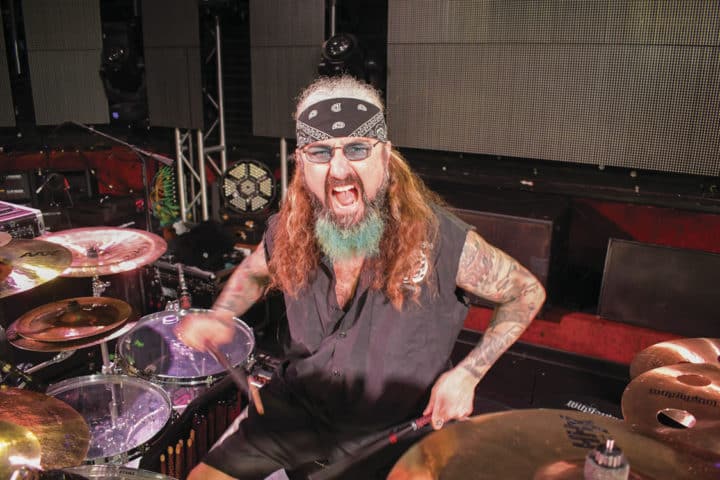
MD: Did you hear Ginger Baker differently?
MP: Ginger was the same as Mitch and Keith as far as I’m concerned. It was that mid 60s English lead drumming style. Ian Paice had a little bit of it, Bill Ward had a little bit of it on the first few Sabbath albums. These guys grew up on jazz, they didn’t grow up on rock like we did. They invented rock, but they grew up on jazz and then kind of brought jazz into rock.
MD: I was going to ask you about Bill Ward, did you listen to old Sabbath much?
MP: Of course! Sabbath, early Deep Purple, and Zeppelin created the prototype for metal. Bill Ward was one of the early double bass drummers. If you listen to the first Sabbath album, there’s a lot of jazz there! He’s playing a lot of jazz time. Listen to “Wicked World” and “Warning” and stuff like that, you could tell that Bill is a jazz drummer being thrown into a hard rock world. I’ve had the fun of covering all these guys, I performed the entire first Sabbath album and the entire Master of Reality album with the band Metal Allegiance. I also did the entire Deep Purple Made in Japan album with Dream Theater. I’ve had these wonderful experiences where I’ve either covered full albums from these bands or I’ve done tribute bands of my own. In all these cases, I’ve gotten to “become them” for a night and really get into their headspace, their persona, and their style. I have even had different replica kits made to really help inspire me to “become” each of those drummers for the night. Those different bands, projects, and tributes really gave me an opportunity to show who my biggest influences were. Advertisement
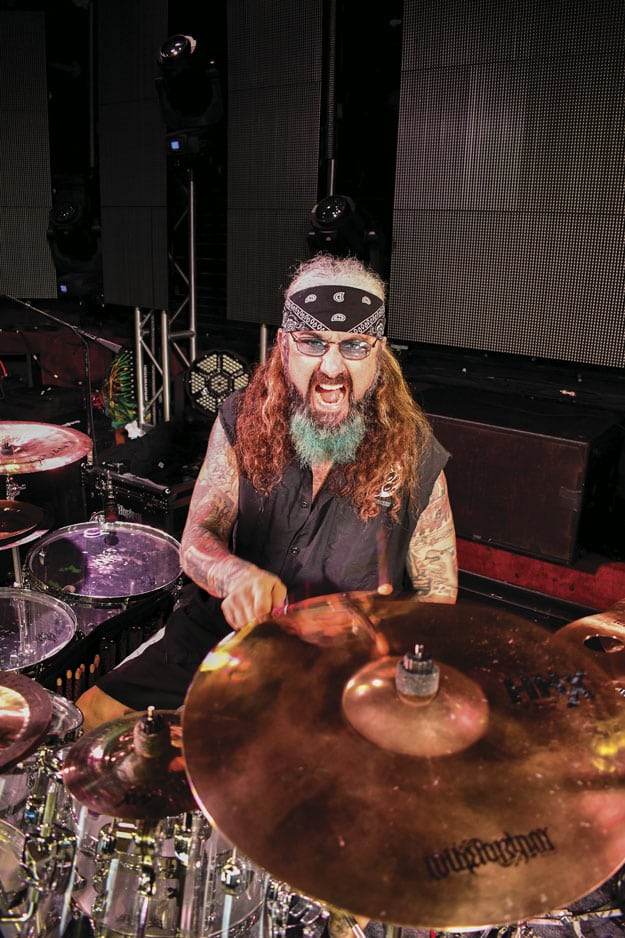
MD: When you went into “Bill Ward mode,” what were your take-aways? Let’s get specific.
MP: Aside from the early jazzy things I mentioned, Bill also had that big sludgy stoner groove which Sabbath kind of invented. When you listen to early Sabbath you can just smell the pot smoke in the room and feel that slow, sludgy, grungy, groove. Bill Ward and Sabbath kind of invented that stoner rock sound. Without him you wouldn’t have guys like Dave Grohl or Chad Smith.
MD: I know you’ve talked a lot about Bonham in the past, but we can’t complete this subject without talking about him. What (besides the obvious Bonham-isms) are your big takeaways when you put Bonham under your microscope?
MP: The sound that that he and Jimmy Page got both in the studio and live is such a big part of him. But I think a lot of people underestimate the importance of the hi-hat and the snare to Bonham’s sound. Everyone immediately thinks of the big kick drum, but his snare and hi-hat sound was amazing. Listen to the “When the Levee Breaks” groove, that’s not just a kick thing, it’s kick, snare, and high hat! Those three elements are so important. Bonham also had finesse. Listen to “Fool in the Rain” with that shuffle. Bonham had a light touch and finesse, he wasn’t always a jackhammer, he could play with a lot of finesse as well. Walking the tightrope between those two styles is what made Bonham so great. Then there was the improvisational element. Listen to the live Zeppelin recordings with them jamming and improvising stuff. There were versions of “Dazed and Confused” that went on for 40 minutes. They were just going off on these different musical tangents and jamming, that’s the sign of a great drummer. A great drummer is somebody that can be in the moment, improvise, and use his ears. You could hear those jams being crafted as they go, they created these alternate musical passages on the spot. That is the sign of (not only) a brilliant drummer but a brilliant musician. I like drummers that think like musicians, that’s the way I’ve always crafted my drumming, I’m not looking at myself as just a drummer. Advertisement
People ask me how I created drum parts for Dream Theater, Transatlantic, or the Neal Morse Band. But I’m not thinking about the drums, I’m thinking about everything. I’m thinking about what everybody else is playing. I’m listening to what the bass, the guitar, and the keyboards are doing. I’m listening to the vocal passages, the melodies of the vocals, the harmonies, and the production. That is the type of drummer I am. I’m a musician first, drummer second. Drums just happen to be my instrument. My language is that of music in general. That’s why I’m a co-writer of all the music I’m involved with and why I’m a co-producer of all the albums I make. All of that is equally as important to me as the drums themselves.
My musical makeup is made-up of a lot of different things. Even though I spent the first 25 years of my career with Dream Theater playing very technical progressive music, if you look at what I’ve done in the 12 years since I’ve left Dream Theater, I’ve branched out to all these other things which are equally important to me. In this conversation we have talked about my classic rock influences like The Who, The Beatles, Cream and Hendrix. That is my classic rock side. I get to really bring that out with The Winery Dogs. Then there’s the whole metal side with what I do playing with Metal Allegiance. That band has me tapping into the roots of metal: Zeppelin, Purple, Sabbath, the next generation like Iron Maiden, Judas Priest, Motörhead, and AC-DC, and the thrash movement with Metallica, Slayer, Anthrax, and Exodus. All of that was a big influence on me as well. I was just as into Lars Ulrich, Dave Lombardo, and Charlie Benante as I was into Terry Bozzio and Simon Phillips. Then you have my poppy side. I’m a huge fan of bands like Jellyfish, Sweet, and Queen. That’s the kind of power pop stuff that I do with the band Flying Colors. Even though that band has Steve Morse and David LaRue in the band, we’re tapping into a more power pop or alternative side that has elements of Radiohead and U2.
That is the giant musical melting pot of what makes me who I am. You’ll notice I’m not mentioning much jazz, or Latin kind of stuff. I can appreciate those elements as a listener but I don’t really tap into those as a drummer, that’s not really the blueprint of who I am. My musical blueprint is metal, prog, classic rock, and pop. Since I left Dream Theater, I’ve been able to channel those different styles and elements into all of the different bands and projects I’ve been a part of. Advertisement
MD: I’m hearing a lot more of your pop thing in The Winery Dogs because the songs are so strong and the three-part harmonies are ridiculous. But I also want to ask about what pop drummer drumming you grew up idolizing. It’s a shame that musicians get pigeon-holed. You get pigeonholed as the prog guy, Lars gets pigeonholed as the metal guy… But when I talk with you guys, I always find that there’s a side that doesn’t get talked about.
MP: You’re right! I do get pigeonholed for having the 100-piece drum kit, playing in a million different times signatures, and 20-minute songs. Yes that’s a big part of what I did with Dream Theater, and still do with my more Prog-oriented bands like Transatlantic and NMB (Neal Morse Band), but if you look at The Winery Dogs everything is scaled down. When The Winery Dogs first came out 10 years ago, I came out of the gates just playing a five-piece Bonham-type kit just to show people that I’m not only about the giant kit. I have a strong appreciation for the pocket and playing for the song. That’s the thing I love about The Winery Dogs. It’s all about the songs. That is the focus first and foremost. Richie’s vocals, our three-part harmonies, having catchy and hooky choruses, concise songwriting, and it is all done with great musicianship sprinkled in. It’s a three-ring circus in terms of the instrumentation. If you listen to the drums, the guitar, or the bass you’re going to be entertained. But at the end of the day, it’s all about Richie’s lead vocals and having hooks and catchy songs that people can remember. I can’t overstate the importance of that. It’s a huge part of what I love about music.
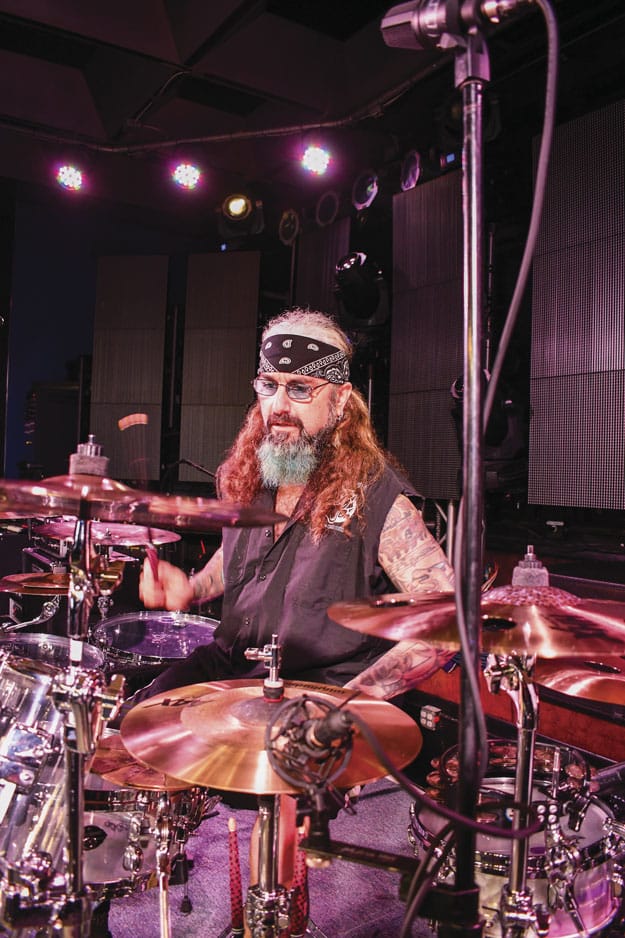
MD: How do you guys write?
MP: All my different bands have different formulas but in Winery Dogs the three of us will get together in a very small room in Richie’s house and we start bouncing ideas off of each other. A song can start with a guitar riff, a bass riff, or drum groove. They all inspire each other. Then we start piecing things together and arranging. In the case of this new third album III, once we had a musical arrangement down, we hit record. In some cases, the drum parts you’re hearing were literally laid down on the same day the arrangement was put together. We record when the songs are very fresh, that’s how I like to work. I don’t like to overthink; I like to be in the moment and capture a musical spirit. In some cases, we would put together one, two, or three songs a day. Then we’ll let those basic tracks simmer and Richie will go write the lyrics and the vocal melodies. Once he has that, Billy and I add our vocals and three-part harmonies. That’s kind of “the formula” for The Winery Dogs. Advertisement
MD: You just mentioned creating a drum track within minutes (or hours) of when you guys write a tune, and that you like to work that way. What happens when you don’t work that way and you do get time to sit with a tune for a while?
MP: There is something to be said for laying down demos and letting everything develop. In the cases where I’ve done that, I have a little more chance to interact with the vocals, or step back and look at the big picture. So maybe a drum part will develop a little bit more because you can interact a little bit more. In the cases where I’ve written music and then didn’t track my drums until weeks or sometimes months later, I’ve had the benefit of that. Honestly, I don’t like overthinking things too much, sometimes you start to second guess things. I like to make a decision, commit to it, and move forward.
MD: Have you ever found yourself overthinking drum parts?
MP: With the stuff I’ve done in the last 12 years since Dream Theater, we don’t have forever to work on recordings. You usually have a deadline, or a label wanting to get something out, or you have tour dates that you have to meet. Everything I’ve done recently is a little bit more regimented and scheduled than it was with Dream Theater. In the early days of Dream Theater, there were periods we didn’t have a record deal, so we had two years to write an album. Sometimes we were looking for a record deal. In those cases, we had years and years to work and develop songs. You could tell that some of my drum parts were really developed because we had so much time. We spent an entire summer writing the song “Metropolis” because we had nothing but time. But that doesn’t work at this point in my career when I have deadlines, tours, and many commitments. Some of my early drum parts with Dream Theater are the parts that most of my fans absolutely love. You look at somebody like Neil Peart, he is that kind of drummer and composer. He spent that amount of time developing every single nuance in a completely methodical way, so I see both sides. Advertisement
MD: Did you ever have to pull yourself back and say I’m thinking way too much about this drum part?
MP: Oh yeah, absolutely! There have been moments when I’m trying to do something that’s overly syncopated or clever and it’s just not appropriate. It’s like that great line from Spinal Tap, “There’s a fine line between clever and stupid.” Sometimes you overthink something because you’re trying to be overly creative. In the later part of my career (and my older age) I’ve learned that the groove is the most important thing. You do that first and then you have the foundation to sprinkle the different things on top.
MD: When Winery Dogs are writing, do you have a lot of input melodically and harmonically?
MP: The Winery Dogs, Richie is the lead singer, Billy and I are only doing harmonies. In the band Sons of Apollo I get very involved with the vocals, the melodic, and harmonic arrangements. It’s different for every band because there are some bands where I sing more than others. In the Neal Morse Band, Transatlantic, and Flying Colors I sing a lot, sometimes even lead vocal parts. In those cases, I’m very involved with the melodies and the arrangements.
MD: You have mentioned a lot of different bands, how many bands are you balancing?
MP: At the moment, it’s actually 10! (Laughs) Some are more active than others, but at the moment there’s The Winery Dogs, Sons of Apollo, Transatlantic, Flying Colors, NMB (Neal Morse Band), Liquid Tension Experiment, Metal Allegiance, I just toured with John Petrucci’s solo band, I just played a reunion show with Twisted Sister, and just recorded a new album with BPMD as well…so I think that’s 10 at the moment! (Laughs) Advertisement
MD: How do you deal with scheduling?
MP: Everyone always asks me how I remember all the music for the different bands But sometimes the scheduling is more difficult than remembering the music. There’s been times where I’ve literally jumped between three different bands in one week. I have even had to go from one band to another within a day. In some cases, those bands are playing two (or three) hour shows, so that’s a lot of music. But to me that comes naturally, I have it all stored in my head.
MD: And the business and the scheduling…
MP: Scheduling can be difficult. Luckily, I’m in control of my own destiny, I’m my own manager so as soon as something comes in, I put it on the calendar. I’m very responsible with keeping an eye on my calendar. There are cases where you don’t have so much control. When I was playing with Twisted Sister or Avenged Sevenfold, I was at the mercy of their schedule. But in most of the bands I just named, I usually have a level of control over my availability, so I must keep an eye on the calendar at all times.
MD: With all of those different bands there has to be conflicts.
MP: It’s not as bad as you would think. I’m very conscious of the scheduling situation. Neal Morse and I are in three different bands together, so that makes it easier. We determine early on, this year is going to be a Flying Colors cycle, or this year is going to be an NMB cycle. We’re very conscious of flip-flopping the cycles between the bands. Advertisement
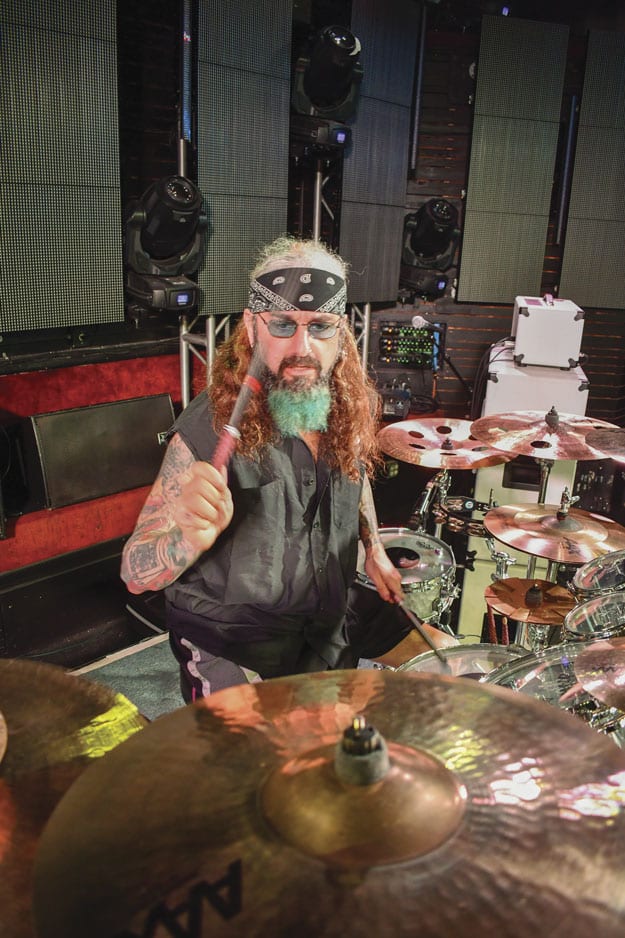
MD: Is that how you envision it? You take a large block of time (a year or six months) and allot it to a band cycle of rehearse, record, and tour?
MP: Yeah, for instance I’m very focused on this upcoming Winery Dog cycle. I know Winery Dogs will be the focus for myself Billy and Richie for 2023, so we’ve blocked it out already. We have an American tour in February March and April, then we’re going to Brazil at the end of April, we come back for another American leg in May, then we go to Europe in June. It’s very regimented.
MD: It’s year to year and cycle to cycle. But what if someone wants to do a band cycle this year while you are in a Winery Dog cycle, what happens then?
MP: Then we have to talk about it. For example, Neal Morse understands that in 2023 I’m focused on The Winery Dogs. That puts NMB, Transatlantic, and Flying Colors off to the side for the year. But we think ahead and in between Winery Dog legs we might start writing and recording the next Neal Morse album. That record won’t hit for nine months or a year, so you constantly have to think ahead.
Also, just because I’m on the road with one band doesn’t mean there’s not activities happening with the others. For instance, the whole time I was out on this last John Petrucci tour I was overseeing the live Transatlantic package that was recently released, and I was overseeing the Winery Dogs packaging and mixes for this new record. Advertisement
MD: You’re a member of these bands, so it’s not like someone else can sub on a Flying Colors gig.
MP: Out of all the bands I’ve named, the only one that could be subbed out would be Metal Allegiance. Metal Allegiance is very part time, we just do one-offs here and there. Even though I’m the only drummer on the studio albums, when it comes to Metal Allegiance live, Charlie Benante and Dave Lombardo have done shows both with me and without me as well. We kind of kind share the live duties, we can mix it up. But in all of the other bands we all have to work together and be conscious of the scheduling.
MD: Scheduling is everything! You said it perfectly when you said that playing the drum parts is sometimes the easy part, the scheduling is the tough part.
MP: One band we haven’t even talked about is Liquid Tension Experiment (LTE.) When we get together in the studio, we’re coming in empty handed and writing and recording spontaneously. That is incredibly progressive and technical music with a lot of odd times and a lot of very deliberate and intricate drum parts. LTE combines the spontaneity with incredibly difficult parts that we have to nail in a very short period of time. That band is one of the more challenging ones that I’m a part of.
MD: When you’re writing tunes like that are you charting stuff out are you or are you remembering it?
MP: I have books with all my charts but I don’t usually write actual notation. The left side of the page will be the map of the arrangement (verse, pre-chorus, chorus, verse two, pre-chorus two, chorus two, instrumental…) The right side of the page will have a drum notation and what I should be playing for each section. For example, verse one I should be on the hi-hat, pre chorus go to the open hat, chorus go to the ride… I’ll write little hints along the way. It’s a very general arrangement map. If there’s a lot of odd time signatures, I’ll map out the patterns as well. Advertisement
What I play is always spontaneous, my fills from section to section are completely improvised. In the studio, sometimes I’ll do maybe three or four takes and then I’ll comp them and pick the fills I like. But those fills are never played again, because live my fills are pretty much spontaneous, moment to moment, night to night as well. A lot of the air drummers in the audience that learn my studio fills are usually pretty disappointed when I’m doing completely different fills live. (Laughs)
MD: So you would describe yourself as an improvisational based rock drummer?
MP: Absolutely!!!
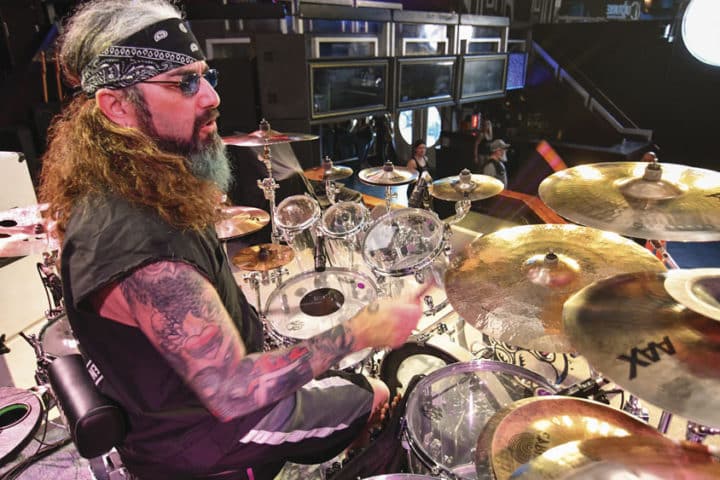
MD: I’ve always wondered how much how much planning and pre-thought goes into your drumming?
MP: It’s all about feel for me. I have this reputation of being very technical because of the progressive music I’ve played. But to be honest, I am not technical at all, I’m actually the furthest thing from a technical drummer that you’ll ever meet. I’m a “just get up there and feel it out” kind of drummer.
There were songs on this latest John Petrucci solo album and tour that were incredibly technical. His latest solo album was done right at the start of the pandemic, so he had drum machine programs for every song. When I’m a hired gun for a session or a tour; I’m there to provide for the artist that’s hiring me. In John’s case I had to learn a lot of the programed drum patterns for his songs. When we played live I had to respect the moments that he wanted very specific drum parts. There was a song on his latest album called the “Temple of Circadia” and there’s a moment in the song before the first verse that only could have been written by a guitar player with a drum machine, you know what I mean? (Laughs) It is so unlike anything a drummer would have naturally come up with; the accents are in strange and weird places. Nailing it in the studio was a challenge but performing it every night was really rough. I actually said to him, “Look there’s a lot of drummers out there that could play this perfectly and would be able to nail this this pattern precisely.” Advertisement
I probably shouldn’t even go there, but Mike Mangini is that type of drummer. I’m sure he would have nailed that part so completely accurately and consistently, but that’s just not the type of drummer I am. I am a feel guy. Give me an eight-bar phrase and let me come up with something. What I play will not sound like a drum machine, it’s gonna be completely about the feel, that’s the type of drummer I am first and foremost. Even in my 25 years of playing incredibly technical and progressive Dream Theater music, it always had to feel good to me first and foremost.
In the 25 years of Dream Theater, my reputation preceded me. I was seen as the giant drum kit guy. When we came out in the late 80s early 90s, music had gone the other way. We brought back the big over the top progressive songs and the big over the top drum kit. I remember playing drum festivals in the late 90s and I’d be there playing with legends that were heroes of mine like Steve Smith, Terry Bozzio, and Simon Phillips. I was the new kid on the block, they just knew my reputation for the giant drum kit. That reputation preceded me, and I felt very intimidated. I felt like I had to get out there and prove myself, it was scary to have to live up to that reputation.
MD: I know you play in a few bands with Billy Sheehan, and you guys sound fantastic together. Can you talk about playing with Billy and the drum and bass relationship?
MP: Playing with Billy is so much fun I really feel like we are a classic rhythm section together. I’ll be honest with you, a lot of my other bands (especially Dream Theater) were kind of drum and guitar rhythm sections. I had that with Petrucci, but a lot of bands that have that: Eddie and Alex Van Halen, Dimebag and Vinnie Paul in Pantera, Lars Ulrich and James Hetfield in Metallica, there’s something to be said for that drum and guitar rhythm section. But it wasn’t until I started working with Billy that I really felt a strong connection with a bass player to create that traditional drum and bass rhythm section. Now Billy and I really have that. Billy’s always been one of my favorite players. Once we started playing together, we really connected. It wasn’t until after Dream Theater that he and I started doing a lot of other stuff together. First, we did a instrumental kind of fusion thing with PSMS which was Billy, Derek Sherinian, Tony Macalpine, and myself doing more fusion instrumental stuff. Then we went on to form The Winery Dogs with Richie. We also play together in Sons of Apollo, so Billy and I have multiple projects and bands and we play differently in each of them. Sons of Apollo is a very locked and loaded kind of band, Billy and I need to be very locked and very precise with them. Whereas The Winery Dogs is a lot more loosey-goosey. What Billy and I do with The Winery Dogs (especially live) is flying by the seat of our pants. We were talking earlier about my fills always being spontaneous, well Billy’s exactly the same. He’s always right on the edge with me. There are at least a dozen moments at every Winery Dog show where Billy and I spontaneously play a fill together in unison. It’s an unspoken thing, we’re not working any of it out in advance, we’re not discussing them, we literally are just jamming and feeling each other, Billy and I have that relationship more than any bass player that I work with, and I’m blessed to work with some great ones. I mean Pete Trewavas in Transatlantic is so great in the prog sense and he’s an anchor. Playing with Dave LaRue in both Flying Colors and in John’s Solo Band, working with Tony Levin in in LTE— he’s one of the all-time greats. He can be completely locked in (like what he does with you know Peter Gabriel or Paul Simon,) but what he does with King Crimson and LTE is so improvisational. Some of the spontaneous jams I’ve had with Tony are so great. I’m blessed to really have worked with so many great bass players in my career. Advertisement
MD: It’s interesting that you drew a difference between the guitar and drum rhythm section and the guitar and bass rhythm section. Can you talk about the differences between the two?
MP: To come back to my relationship with John Petrucci specifically for the 25 years in Dream Theater; he and I were kind of the rhythm section, and it was a unique relationship. We were co-writers of all those Dream Theater songs as well as co-producers of all those albums. We had a very locked drum and rhythm guitar relationship. Getting to tour with him again this past year was our first time touring together since I left Dream Theater. Having that chemistry on stage with John again has been so great. The chemistry we had in Dream Theater, in LTE and even with his solo material is very much that great drum and guitar relationship.
MD: Speaking of relationships, we haven’t mentioned the relationship with Neal Morse.
MP: Neal and I probably have the deepest music connection of all, and he’s neither a guitar player nor a bass player. I think we have made almost 50 albums together. Together we have NMB, Transatlantic, Flying Colors, and we also have Yellow Matter Custard. I also did almost all of his solo albums as a hired gun. He and I have an incredibly deep musical relationship. All these bands (and people) are about collaboration. It’s all about the musical chemistry with the people.
MD: Do you ever think about the drum and keyboard rhythm section?
MP: Neal and I have to have a different musical relationship in each band. In the Neal Morse Band he’s obviously the leader, he’s the biggest contributor to the music, and he’s front and center. The rest of us are working with him. But he and I are more equal collaborators in Transatlantic, because we’re co-leaders of the band. He and I actually share the front of the stage in that band. We share the vocals and co-lead the band. In Flying Colors, he and I are together in the back. It’s different because we’re supporting players to Casey’s lead vocals, and Steve Morse and Dave Larue’s instrumentation. The sign of a great relationship is when you can adapt to different roles and different chemistries. Advertisement
MD: That’s also the trait of a great musician.
MP: Then there’s my hired gun side where I have toured or played shows with bands like Avenged Sevenfold, Twisted Sister, Stone Sour, Fates Warning, Overkill, and as a hired gun on John Petrucci solo tours. As a hired gun I’m there to literally play drums and provide a service. I enjoy that side as well.
MD: These days we all must wear all sorts of different hats. Not many successful musicians today are “just” wearing one hat.
MP: You’re right! I like all of the hats equally.
MD: How about remembering all these bands’ music?
MP: I have been blessed with an elephant’s memory. That pisses off all the band members I’m in bands with. (Laughs) I don’t have a photographic memory, but once I play something live it’s in the vault for life. If I’ve played it live or if I’ve written and recorded it in the studio, it’s in there. The only times I really have to do homework for a gig is if it’s a hired gun gig and I didn’t play on the studio version. In those cases, I’ll really have to do some homework and prep.
Back in Dream Theater I used to write a different set list for every show. A lot of times the other guys would have to spend a tremendous amount of time learning this stuff and preparing it. For our 20th anniversary tour I wanted to put the very first song that we wrote as teenagers at Berklee into the set. It was a song called “Another Won” and we hadn’t played it since we were 18 years old. I literally showed up to the first rehearsal 20 years later and just played it from memory. Advertisement
MD: Let’s talk about some Winery Dogs tunes from the new record III, “Xanadu” is the first single, can you give me some background about that?
MP: That was one of the first ones that came together during the writing. With “Xanadu” we put the music together and went off and had dinner. Then Billy and I went back to our hotel and Richie went back to his house. That night, Richie was inspired to lay down some melodies and vocals. The next day he picked us up from the hotel and played us the vocal tracks. In a lot of cases what you’re hearing on the album are Richie’s vocals from the very first night of tracking. “Xanadu” was almost completed right there and then. It’s kind of a shredder and a barn burner, it’s got a lot of unison parts between Billy and Richie it’s a good first impression after being away for many years.
MD: How about “Mad World”?
MP: “Mad World” is the second single. It comes from more of the funky R&B side that Richie brings to the band. Billy does that very well too. Richie’s got a funky Prince vibe to him, and Billy is a big fan of that Motown kind of sound and style. “Mad World” falls into that school. I get to lay it down in more of a Chad Smith way. That song is all about the hook and the and the chorus, I’m just laying down the foundation and grooving.
MD: How about “Pharaoh”?
MP: “Pharaoh” is literally the first thing we jammed on during these sessions. The vocals didn’t come together until much later. “Pharaoh” starts as a traditional Winery Dog song, but the last half of the back end is completely improvised and jammed. That is something that we do live a lot, we’ll have these extended jams that change from night to night. The second half of “Pharaoh” and “The Red Wine” are two examples where we just literally jammed in the studio, and we left it all in. What you’re hearing is the three of us in a room together completely and spontaneously creating a song. Advertisement
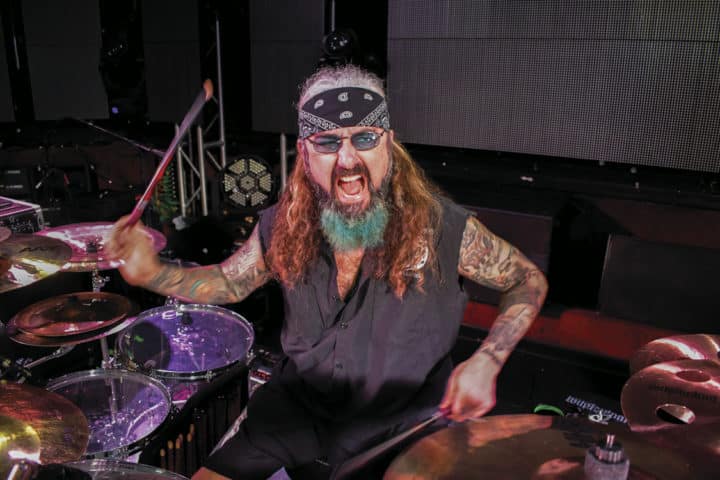
MD: What’s a “typical” Winery Dogs song?
MP: Typical Winery Dogs songs have Richie’s vocals as the spotlight, big three-part vocal harmony choruses, and a serious groove for the verses. I think the classic Winery Dog songs are songs like “Desire,” “Elevate,” “Oblivion,” “Captain Love,” and from this album “Mad World,” and “Xanadu.”
MD: Tell me about “Breakthrough”?
MP: “Breakthrough” is going to be the third single. To my ears and from my perspective we are tapping into more of a Foo Fighters thing. I get into a Taylor Hawkins-Dave Grohl vibe, it’s kind of hooky chorus but the verses are kind of four on the floor pocket things. I love Taylor Hawkins and losing him was so tragic, but I also love Dave Grohl as a drummer, I think people forget what a legendary drummer he is.
MD: How about “Rise”?
MP: “Rise” is a bit of a Chili Pepper vibe. As far as the drumming goes, there’s a nuance at the very end. There’s a pattern that’s reoccurs throughout the main riff of the song, but at the end I mess with it and give two extra sets of fives within the pattern of constant threes. It’s at the very end of the song, just when you thought you’ve got the pattern down it’s a little nuance to kind of mess with the drummers. Advertisement
MD: There’s nothing wrong with that! What about “Stars”?
MP: “Stars” is a really vibey song with a long extended middle guitar solo that really builds and breaks down to just me and Billy in a groove. We take our time to develop into a really long extended solo. “Stars” is one of my favorites on the album because it really builds. I remember playing some cool Pink Floyd Live at Pompeii jams for the guys and suggesting that we should try to build something like this. I pulled up a few more musical references as examples of letting everything breathe, build, and develop.
MD: Do you bring in a lot of musical references when you’re recording?
MP: I do that constantly. I think it sometimes bothers some guys when I point out a musical reference, because (in their eyes) it distracts them to the point that the reference is in their head. But I think one of my fortes and strengths is the fact that I’m such a fan and I have this rock encyclopedia in my brain to draw from. You can throw out anything by Zeppelin, The Stones, or anyone else and I can reference it. Almost every song has been written a zillion times over, you can only do so much with 12 notes. I have a constant musical frame of reference. Sometimes it does annoy the other band members, and I have to pull it back and not point stuff out in order to let something grow, develop, and become something of its own. Different strokes for different folks. When we were doing “Xanadu” on this album I couldn’t believe that Richie didn’t know the Rush song of the same name, but he didn’t, that’s fine.
MD: How about “The Vengeance”?
MP: “The Vengeance” is another one in the Foo Fighters realm. Straight ahead with a really strong hooky chorus.
MD: How about “Gaslight”? I know you’re an old movie nut, did that come from the old film Gaslight?
MP: No. “Gaslight” was my choice to open the record. It’s the most barn burning of all the tracks on the album. It comes out of the gate just swinging with a million notes. It’s a very fast old school Alex Van Halen double bass shuffle kind of thing. Like “Hang ‘em High” or “I’m the One.” It will probably open the live show. It’s just one of those barnburners from the tradition of “Oblivion” from our previous album. Advertisement
MD: So it didn’t come from the old movie? (Laughs)
MP: No, but movies are my biggest passion besides music. I have my own home theater, and I’m a HUGE movie fan.
MD: The last song I want to ask you about is the ballad “Lorelei”?
MP: That’s a side of The Winery Dogs that I love. The first album had “Damaged” and “Regret” both of which are great ballads. So “Lorelei” is kind of the ballad for this album. I just pull it back and play for the song, it’s all about the groove, pocket, and being as tasty as possible. I’m trying not to crash as much as possible. In fact, now that I’ve listened to the final, this is one of those cases where if I had a little more time to think it over, I probably would have crashed less. When you’re playing a ballad, sometimes the big challenge is not hitting every downbeat.
I recently discovered that there’s literally two crashes on the Stones song “Honky Tonk Woman.” There’s a crash at the very entrance after the cowbell, and Charlie doesn’t crash again until the very final crash of the song.
MD: That is a great example of restraint by Charlie Watts sometimes restraint can be an incredibly tasty musical tool. Are you still using a small kit in the in The Winery Dogs?
MP: The configuration I’m using for this tour is the same configuration that I had on the John Petrucci solo tour. It’s a single kick with two Octobans and a 10” as my rack toms, so it’s really only three small toms up front, and 14 and 16” floor toms. It’s a smaller setup and much smaller drums. I love having the Octos as my first two rack toms, it’ a lot of fun and a very unique sound. My 14” Melody Master snare is my main snare and my 12” Melody Master is on the side. Advertisement
The touring kit is part of the Acrylic Star Classic kit that Tama made for me back in 2007. I still get a lot of mileage out of it whenever I can. I used the whole kit with Avenged Sevenfold, Twisted Sister, and Adrenaline Mob. I scale it down and use it with The Winery Dogs and John Petrucci. I like mixing and matching kits. I still use a big kit for Sons of Apollo and Twisted Sister. But I like mixing it up from band to band and project to project, it inspires me. Every time I get behind a different kit it’s inspires me to approach things a little differently.
MD: After The Winery Dogs cycle what’s coming up in the future?
MP: The Winery Dogs is the focus for 2023, but there is a live Transatlantic release coming out in 23, and there will be some live Neal Morse band stuff in 23. There is always new stuff in the pipeline, but as far as touring it’s all Winery Dogs for 2023. I have a little hole in the summer where Billy has stuff with Mr. Big. So there’s a situation where I know I’ll have a window at the end of the summer to be free to do some studio stuff or do a tour. That’s how you do it, you put stuff in the calendar, and you fill in the blanks.

